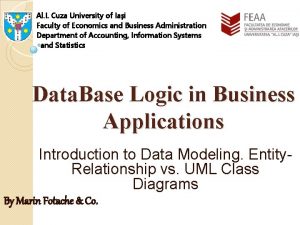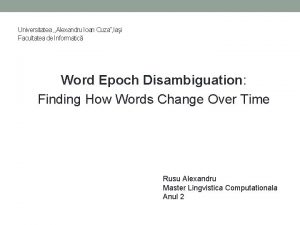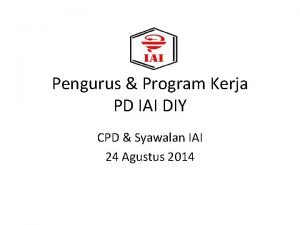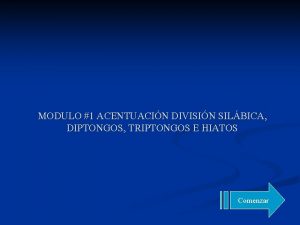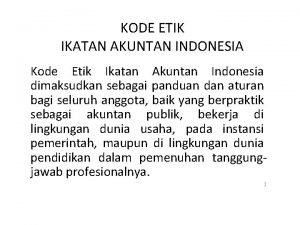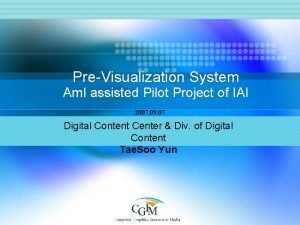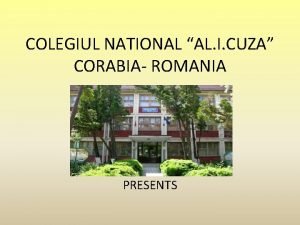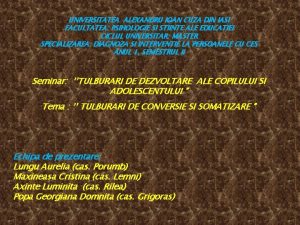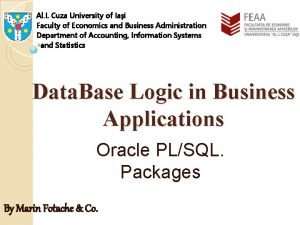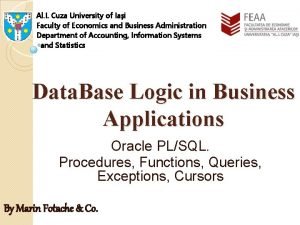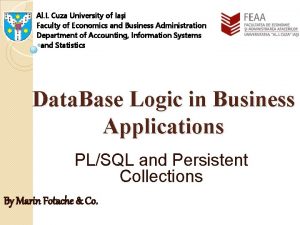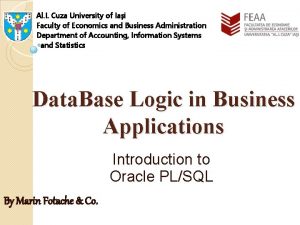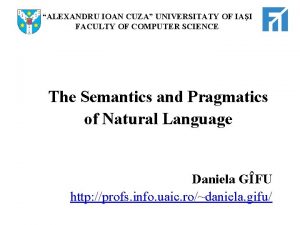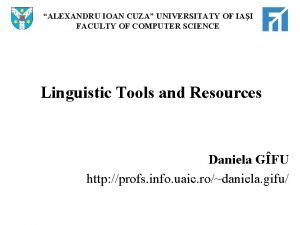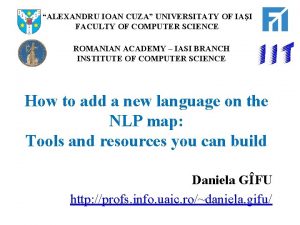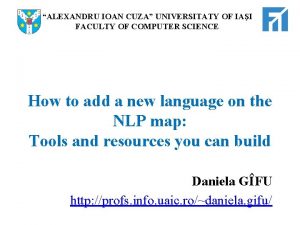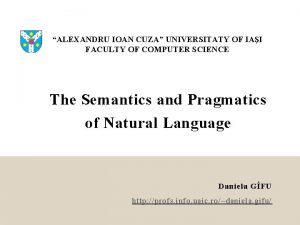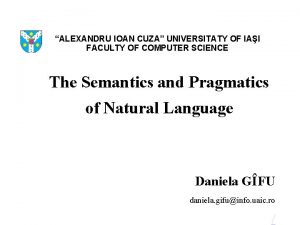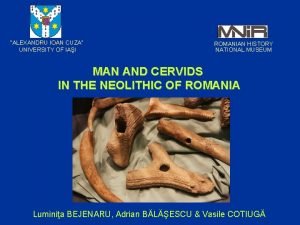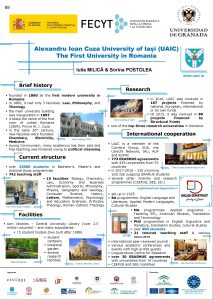Al I Cuza University of Iai Faculty of
















- Slides: 16

Al. I. Cuza University of Iași Faculty of Economics and Business Administration Department of Accounting, Information Systems and Statistics Data. Base Logic in Business Applications Course outline By Marin Fotache & Co.

Some bad news �In software development, databases are NOT as important as they used to be �Ten-fifteen years ago, business apps were developed around databases �Those were DB golden years (DB dictatorship ) �Now many devs are DB “agnostics” (sometimes completely ignorants) �Database courses are, in most cases, taught awfully (all over the world) – the main target is database software development (Oracle, MS,

Common Data. Base course plan http: //mines. humanoriented. com/403/books/fdbs 02. pdf

Consequences of technically-focused DB courses �Students know a lot of details about what’s inside of a DBMS (buffering, caching, logging, …), not much about how to use a database �Mastering mathematical/theoretical issues about database normalization, but insufficient knowledge about how to properly design a database schema �Most of the software developers tend to include all of the application logic (including database query, security, logging) into the application layer (Java, . NET etc. ) �There is a chronic poor use of DBMSs features

And now for the good news �Apart from software development, “dataification” is one of the most vivid phenomena on the IT market (and definitively a buzz) �Databases are part of the data-ification buzz �The broad area of data-ification is usually labelled as Big Data �The main difference between Databases and Big Data is that usually Databases deal with (more) structured/rigorous data, whereas Big Data deals with semi and non ( ) structured data (generated by mobile devices, sensors, web logs, social networks etc. . )

Data ramifications & courses at SIA/SDBIS �Databases – dealing mostly with structured data ◦ Logical Database Design: Data. Base Logic for Business Applications (DBLBA) ◦ Database query: DBLBA ◦ Database Logic (stored procedures, triggers, scheduler): DBLBA ◦ Physical Database Design (including database optimization) – Data. Base Administration (DBA) ◦ Database Administration – DBA �Data Warehouses – dealing also with huge volumes of structured (in some different ways, such as starschema, snowflake) data ◦ Business Intelligence / Decision Support Systems (BI/DSS) ◦ Data Warehouses, Data Mining and Knowledge Discovery (DWDMKD)

Data ramifications & courses at SIA/SDBIS (cont. ) �No. SQL databases – flexible schema (schemaless) and scalable data stores: Polyglot Persistence and Big Data (PPBD) ◦ Document Databases (Mongo) ◦ Columnar Databases (Cassandra, Hbase) ◦ Graph Databases (Neo 4 j) �Big Data – Hadoop Ecosystems: Polyglot Persistence and Big Data (PPBD) ◦ Hadoop – HDFS, Map. Reduce, Yarn ◦ Hive �In-memory database systems: Polyglot Persistence and Big Data (PPBD)

Data ramifications & courses at SIA/SDBIS (cont. ) �Data Integration: ◦ Information Integration and Web of Data (IIWD) ◦ PPBD �Data ◦ ◦ Analysis, Data Mining, Data Science BI/DSS PPBD DWDMKD Information and Knowledge Management (IKM) / Knowledge Management, Analytics and Data Science (KMADS)

DBLBA Course Content (see also Course Description on FEAA portal) �Database fundamentals (recap) �Database Query – SQL (recap + pivot) �Basic programming in Oracle PL/SQL ◦ ◦ ◦ ◦ Bloc structure Procedures Functions Cursors, exceptions Collections in PL/SQL: associative arrays Persistent collections: SQL for collections in PL/SQL Packages Triggers

DBLBA Course Content (cont. ) �Logical Database Design ◦ Domains and Types ◦ Entity-Relationship diagrams ◦ Temporal Validity, de-normalization, postnormalization �Common ◦ ◦ ◦ ◦ Patterns in Database Modeling Heterogeneous items (products and services) Packages of products and services Metadata Manufactured products (recipes and manufacturing) Identifiable products Standard and customizable configurations Discounts

DBLBA Course Content (cont. ) �Implementing ◦ ◦ ◦ Database Logic using PL/SQL Managing denormalized/calculated attributes Sequences Contexts Logging User access control through views and triggers �Implementing Business Rules within Database Logic ◦ Business Rules examples ◦ Business Rules and triggers ◦ Business Rules and schedulers �Some PL/SQL Utilities (Dynamic SQL, . . . )

Strange facts �DBLBA is common to both SIA and SDBIS master programmes curricula �The course will be taught in English (with an awful accent ) �References will be in both Romanian and English �Main books (Fotache et al. 2003, Fotache 2009) and some video-tutorials are in Romanian �Most video-tutorials are in English (youtube) �For SIA students, DBLBA labs and assessment (homework/tests/project) will be in Romanian

Strange facts (cont. ) � Homework solution and the two project sections are prepared and presented in teams of three students; team members come from the same master programme � Teams will get full access to their unique Google Drive directory; all homework/project solution files will be uploaded on this directory until the deadline decided by both assessors and students � Each team will choose an interval (usually 15 minutes) for homework/project presentation � Presentation intervals could be placed not only within official timetable, but also after the course (19: 40) and/or other days of the week to be proposed and decided by both assessors and team members � Every homework will be assessed by the same

Strange facts (cont. ) � All the student team members must present (a chosen part from the solution) each homework � In special cases (announced in advance), the students forced to leave Iasi at presentation time are allowed to use Skype � Missing student will not receive the grades for that homework even she/he actually worked � For every presented homework, each team receives from the assessors a number of points (e. g. 25 points out of 30); this includes presentation performance � Points will be split among team members (by them, according to their contribution) � During labs, there will be three invidual tests (see course description); bibliography/references will be available � It is not necessary that every team member to get a

DBLBA/LBDAA Team Marin Fotache FEAA Cătălin Strîmbei FEAA Kristó Róbert Synygy Arezzo Sky George Talabă Arezzo Sky Lucian Lazăr Alexandru Tică SCCC Fits Optymyze

Additional information about the course �It is (unbearable) dense �Based to a large extent on individual and team work �Assessments are scheduled almost every other week (homeworks, project parts) �Apparently, course/lab attendance is not compulsory �Course lectures are dedicated to discussions and case-studies not available (in most of the cases) in references/tutorials �Labs dedicated to homework/test/project assessement and feedback, and also to solving
 Iai university
Iai university Cuvinte cu iai
Cuvinte cu iai Precizeaza trasaturile morale ale preotului trandafir
Precizeaza trasaturile morale ale preotului trandafir Pd iai diy
Pd iai diy Palabras de triptongo
Palabras de triptongo Ikatan akuntansi indonesia adalah
Ikatan akuntansi indonesia adalah 4 palabras con triptongo
4 palabras con triptongo Iai
Iai Liceul teoretic alexandru ioan cuza corabia
Liceul teoretic alexandru ioan cuza corabia Facultatea de psihologie iasi
Facultatea de psihologie iasi Ambulatoriu cuza voda iasi
Ambulatoriu cuza voda iasi Alexandru ioan cuza
Alexandru ioan cuza Liceul alexandru ioan cuza ploiesti
Liceul alexandru ioan cuza ploiesti Clemson university electrical engineering
Clemson university electrical engineering University of kragujevac faculty of technical sciences
University of kragujevac faculty of technical sciences Hacettepe university faculty of medicine
Hacettepe university faculty of medicine Semmelweis university faculty of medicine
Semmelweis university faculty of medicine
